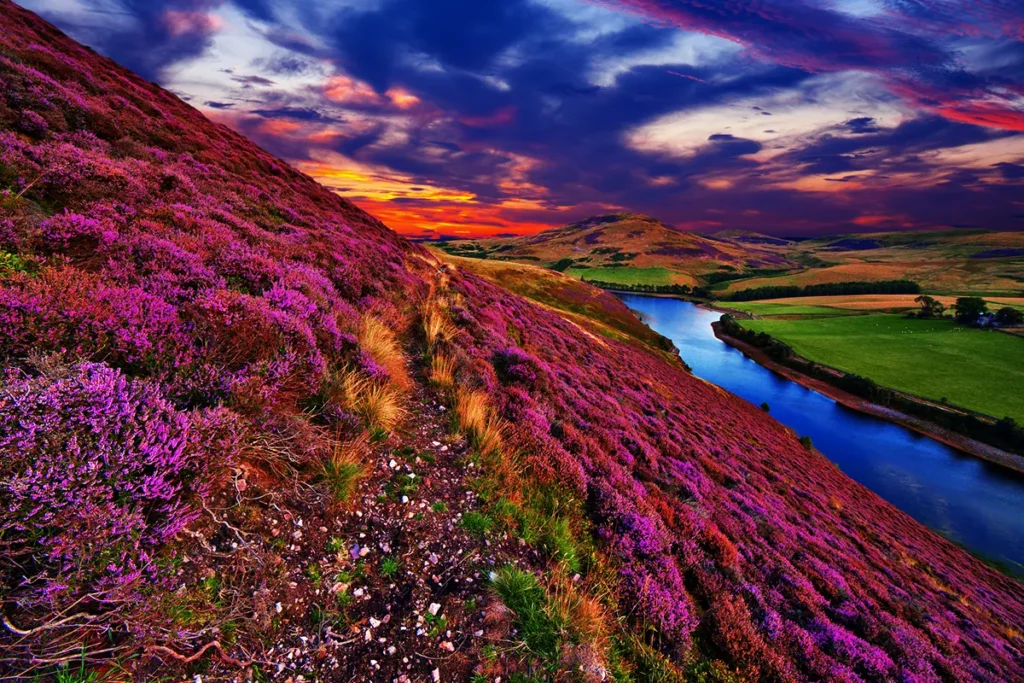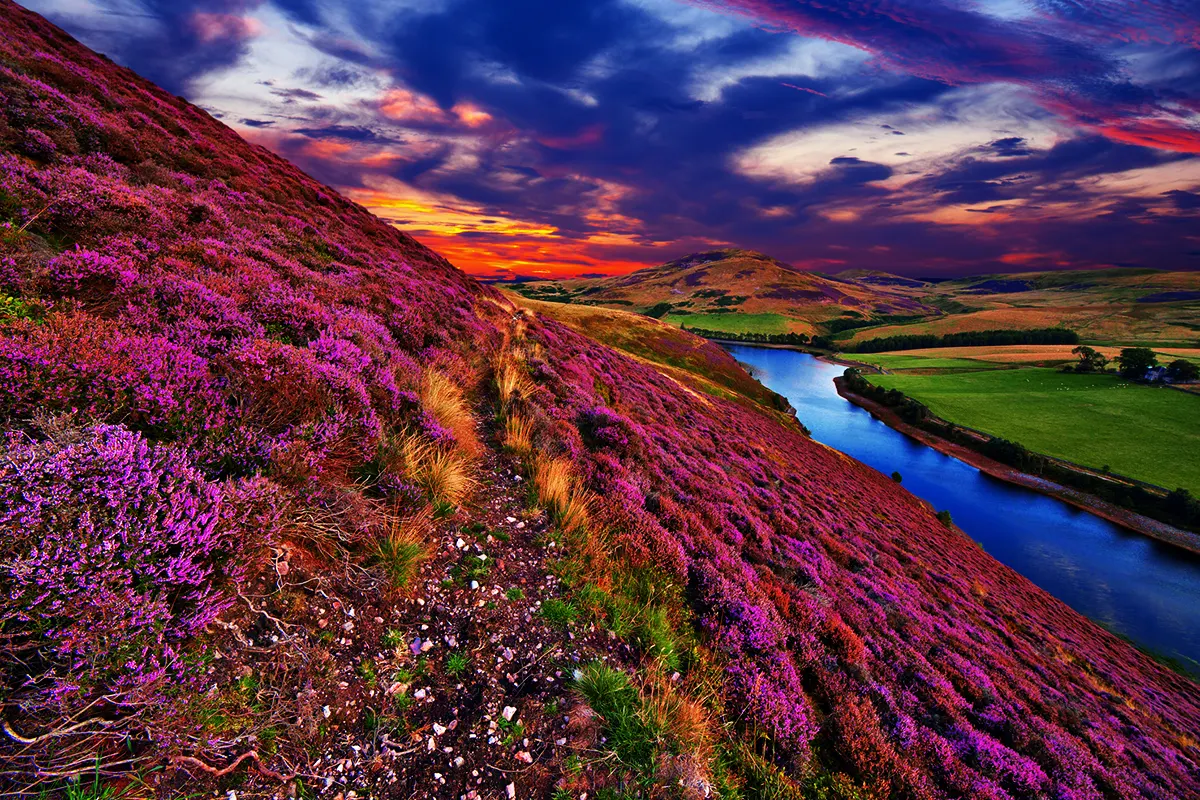
uTalk’s Scottish Gaelic translator, Iona Macritchie, has grown up using one of the last remaining endangered languages of the British Isles. To mark St Andrew’s Day (Nov 30), she told us all about the dozens of different words Scottish Gaelic has for types of rain, the way the letters of the alphabet are linked to trees, and explained the language’s enduring bond with its surroundings.
The Gaelic Tree Alphabet
A is for Ailm (Elm), B is for Beith (birch) and C is for Coll (Hazel) and so begins the Gaelic Tree Alphabet which contains just 18 letters.
According to the Forestry Commission Scotland, the Gaelic Tree Alphabet was used to teach Scottish children their letters in times gone by.
There are various versions of the Gaelic Alphabet – some with different combinations of tree names –and they evolved from an alphabet called Ogham used in Ireland in the 4th century AD.
“Some people say the Scottish Gaelic letters were named after trees because their original shapes in Ogham resembled trees and branches,” says Iona Macritchie.
“But, whatever the reason, the Gaelic Tree Alphabet shows a lovely connection between the language and nature,” she adds.
Iona has spoken Scottish Gaelic since birth, used to teach it at Edinburgh University, works at BBC Scotland’s Gaelic radio station in Inverness and does translation work in her spare time.
She says she is often asked questions about the language, especially the meaning of the many Gaelic place names and landscape features which are scattered across Scotland.
“The language has left its imprint on so much place names in Scotland,” Iona explains.
“Knowing what different place names originally meant is a really popular gateway for people to get into learning the language,” she adds.
Modern-day words derived from Scottish Gaelic include ‘glen’ from ‘gleann’ (valley), ‘loch’ (lake) and ‘inver’ from ‘inbhir (river mouth) which gives its name to the Scottish city of Inverness.
There is also Glasgow from ‘Glaschu’ (green hollow), Kintyre ‘Cinn Tire’ (region’s end) and the River Dee ‘Uisge Dhè’ (water of God)!
How many words for hills?
But where the language really excels is in the many different names it has for landscape features – particularly hills.
“There are a surprising number of names for different types of hills according to their size, shape and even what grows or doesn’t grow on them!” Iona says.
To mention a handful:
- ‘Beinn’ is a generic word for hill, particularly big which is where Scotland’s iconic mountain Ben Nevis got its name. (Nevis comes from the Gaelic word ‘nibheis’ and is commonly translated as ‘venomous’ or ‘malicious’, presumably as a reference to the danger it poses to climbers.)
- ‘Cnoc’ means a small, rounded hillock.
- ‘Meall’ is a bare, rounded lumpy hill.
- ‘Càrn’ is a stony hill.
- ‘Sidhean’ is a hill where fairies live!
- A hill can also be ‘garbh’ (rough), ‘eagach’ (notched), gaoth (windy), ‘sneachd’ (snowy), ‘coinnich’ (mossy) or ‘corrach’ (steep).
- While hills which look like a stooped person can also be called a ‘bodach’ (an old man) or ‘challeach’ (an old woman).
- And the word ‘coirie’ is commonly used to describe a hill with a glacial hollow. (Curiously the word ‘coirie’ also means ‘kettle’ in Scottish Gaelic, perhaps because of the shape.
Gaelic names
The Gaelic language is full of fascinating nods to its history like the common Scottish prefix of ‘Mac’ which means ‘son of’. But it’s not just someone’s surname that gives clues about their genealogy.
Iona, whose family hail from the Scottish Isle of Lewis, explains: “The islands are a close-knit community and family is important. So people are interested not so much in your surname, which doesn’t tell you that much, but who you are related to. There’s even a phrase – ‘cò leis thu?’ – meaning ‘who do you belong to?’”
“If I was in my father’s part of the island, for instance, I would introduce myself in Gaelic as ‘I am Iona, daughter of Callum of the hill’ and they would know exactly whose daughter I am,” she says.
“Sometimes the names can even go back several generations so people might say ‘I am Donald, son of Calum, son of Donald, son of Seumas,” Iona adds.
This form of name, which references your family line, is called a patronymic and, according to Collins Dictionary is aname ‘derived from its bearer’s father or ancestor’.
Your female forebearers can be referenced too, in which case the name is technically called a matronymic.
Iona thinks her father’s patronymic came about because he loves being out in the hills and ‘his friends probably coined it at school’.
And, for the record, Iona’s dad’s patronymic references a ‘creag’ – which she describes as ‘a kind of rocky outcrop sort of hill’.
Famous Scottish weather
If, like us, your heart is starting to yearn for this close-knit world of hills and mountains, let’s spare a thought for the Scottish weather.
“We love to talk about the weather – all different kinds of weather – but we particularly like talking about bad weather!” Iona says with a laugh.
“It’s not that Scotland has so much of it, it’s just we have lot of words for it. There’s also lots of words for different types of rain, snow, wind and fog.” she continues.
“We even have a Gaelic expression to describe a day when the weather throws all different sorts of things at you – it’s called ‘the day of the seven weathers’ (là nan seachd sian)” Iona adds.
Gaelic words for rain include:
- ‘Dìle bhàite’ – a heavy downpour
- ‘Sgùrachadh’ – misty rain
- ‘Steallan uisge’ – spatters of rain
- ‘Ceòban’ – misty drizzling rain
- ‘Dòrtadh’ – pouring rain
- ‘Plom’ – a spot of rain
- ‘Marchach sìne’ – driving sheets of rain
- *‘Uisge’ – a general all-purpose word for rain which is used in the Scottish Gaelic content on the uTalk app.
Scottish Gaelic and uTalk
Iona first worked on translating the Scottish Gaelic language for uTalk around 14 years ago, starting off with CD-Roms and then progressing to apps, and is a great believer in the importance of language learning.
“It’s really exciting that we were able to work with uTalk to make the first Scottish Gaelic app back in 2009 and that people are now able to learn the language on so many platforms,” Iona says.
“Learning Scottish Gaelic is a really good way for people to connect with Scotland or their Scottish ancestry and heritage. Gaelic is also much easier to learn than English because it’s more logical,” she adds.
Scottish Gaelic is in the same language family as Irish and, she says, there is enough common ground for them to be mutually comprehensible.
Iona explains: “Knowing Scottish Gaelic means I’ve always managed to get by in the Irish language and had a very warm welcome in Ireland. And, even though there is less language cross over with the Gaelic spoken in Wales, as fellow Celts, there is always a warm welcome there for Scottish Gaels too!”
Encouragingly, there is a lot more interest in people learning Scottish Gaelic than there used to be and, as a former Gaelic teacher, Iona often gets approached by individuals for help with personal translations.
“One popular request I get fills me with fear and dread,” she says. “It’s ‘can you translate this into Gaelic for me, I’m going to have a tattoo’. Even when it’s words I am 100% sure of, it fills me with anxiety because it’s such high pressure if I got it wrong!”
“People ask for translations of all sorts of things like
‘Love Scotland’ which is quite often requested from people in the US, Canada and Australia who have a strong sense of their Scottish identity,” she adds.
The sentiment ‘alba mo ghràidh’ (meaning ‘love Scotland’ but literally ‘my beloved Scotland’) is a fitting testimony to the feelings inspired by the country. But perhaps the best Scottish Gaelic turn of phrase we should learn is the uplifting answer to the question ‘how are you?’.
“If someone asks someone how they are, a very common answer is ‘as happy as a shoe’ – tha mi cho sona ri briòig” Iona explains. “It’s because, if you imagine a worn-out shoe with the sole coming away, it looks like it’s smiling!”
Want to learn some Scottish Gaelic yourself? Why not start with the uTalk app? Just click here to download the app (for free!) and you can try it out right away.
And keep reading for some more information about the language!
A Five-Minute Guide to Scottish Gaelic

History
Scottish Gaelic is considered the founding language of Scotland and is thought to have been introduced by settlers from Ireland around 500AD. These settlers founded a Gaelic kingdom on Scotland’s west coast in present-day Argyll.
At its peak in 1100 AD, the language was spoken by people all over Scotland as shown by the many Gaelic place names which are still used today.
Role in education
Usage of the language declined from the 17th century when anti-Gaelic laws were passed. In fact, up until the middle of the 20th century, Gaelic speakers attending school education only spoke Gaelic in the home because Gaelic wasn’t allowed in school.
There is now a Gaelic Language Board (Bòrd na Gàidhlig) charged with its preservation and the language is taught in many Scottish schools.
Official figures from 2018 show that 14 of Scotland’s 32 council areas offer some ‘Gaelic medium education’ (lessons taught in Gaelic). It is also possible to take Gaelic at secondary school level – like people in the UK take English – and Scottish Gaelic is a university degree subject. And, although the proportion of pupils receiving some kind of education in Gaelic is small (at less than 2% of the student population), it is growing.
Renewed support for the language means that signs and official documents are now frequently written in both English and Scotland Gaelic and there are TV and radio shows broadcast in Gaelic.
This is all important because a 2011 census of Scotland found that only 1.1% of the Scottish population (around 57,000 people) were Gaelic speakers.
Language family
The languages of Scottish Gaelic, modern Irish (also called Irish Gaelic) and Manx (spoken on the Isle of Man) all developed from the same root of Old Irish. Over the centuries they developed their own separate identities but they still share some common elements.
Scottish Gaelic also has language relatives in Canada after many Gaelic speakers from Scotland emigrated there between 1773 and the 1850s. Many of these speakers settled in Canada’s Nova Scotia and Prince Edward Island.
Scottish Gaelic is also related to Welsh, Cornish and Breton but the ties between these languages aren’t quite as close as with Irish and Manx.
Future of Scottish Gaelic
It is listed as ‘threatened’ by the Endangered Languages Project and ‘endangered’ by UNESCO. Fears for the language’s survival are also regularly in the news.
Native speaker and former Gaelic teacher Iona Macritchie explains: “Lots of Gaelic communities and heartlands are struggling with depopulation and an ageing population. So the challenges of keeping the language going are tied in with the challenges of lots of rural parts of the country.
“But there are lots of positive signs – the Gaelic medium schools are all really popular and well subscribed, lots of people are taking Gaelic classes and loads of people using apps like uTalk,” she adds.
Other languages in Scotland
Scottish Gaelic (Gàidhlig) is one of the four languages recognised by the Scottish government as customarily spoken in Scotland. The others are Scots, English and British Sign Language.
Approximately 30% of the population in Scotland are believed to speak Scots, one per cent speak Scottish Gaelic and 99% speak a variety of English (also known as Scottish English).
The Scots Language
While Gaelic is said to be the oldest surviving language in Scotland, it tended to be concentrated more in the Highlands and Islands of Scotland particularly after the 16th century.
Many people in Scotland’s Lowlands and Northern Isles instead spoke – and continue to speak – what we now call Scots. Scots traces its origins back to the tongue of the Angles who settled in Lowland Scotland and North-East England around AD 600. The version spoken in Scotland gradually grew apart from its sister tongue in England and by the 15th century had developed its own identity. Today Scots is officially recognised in the UK under the European Charter of Regional or Minority Languages.
uTalk and the languages of Scotland
The uTalk – Learn Any Language app features Scots and Scottish English as well as Scottish Gaelic. Usefully, people who already speak Scots, Scottish Gaelic or Scottish English can also learn any of more than 150 new languages (e.g. French or German) from their native language as translation is always available. (Many thanks to Iona Macritichie and all our lovely translators!)

Wonderful information. It helps to bring the language to life. Thank you.